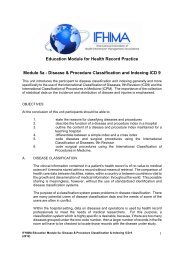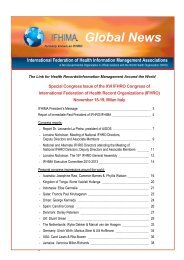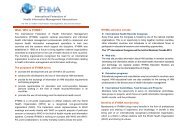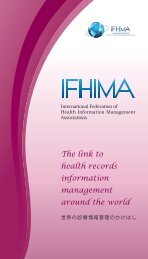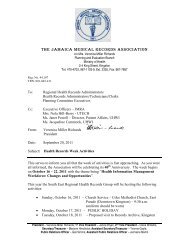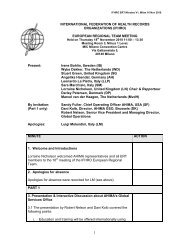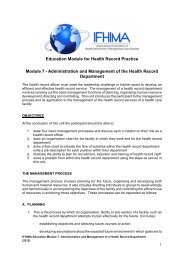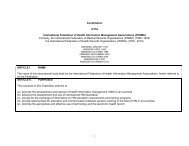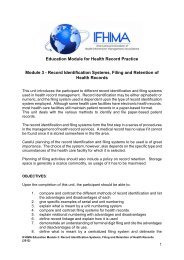A clinician's guide to record standards â Part 1 - The Royal College ...
A clinician's guide to record standards â Part 1 - The Royal College ...
A clinician's guide to record standards â Part 1 - The Royal College ...
You also want an ePaper? Increase the reach of your titles
YUMPU automatically turns print PDFs into web optimized ePapers that Google loves.
Information Governance<br />
A Clinician’s Guide <strong>to</strong> Record Standards – <strong>Part</strong> 1:<br />
Why standardise the structure<br />
and content of medical <strong>record</strong>s
Contents<br />
Page 3<br />
– A <strong>guide</strong> for clinicians<br />
Pages 4 and 5<br />
– Why have <strong>standards</strong> for the structure and<br />
content of medical <strong>record</strong>s<br />
Pages 6 and 7<br />
– What are <strong>standards</strong> for the structure and<br />
content of medical <strong>record</strong>s<br />
Page 8<br />
– <strong>The</strong> Electronic Patient Record<br />
Pages 10 and 11<br />
– Where are we now<br />
Pages 12 and 13<br />
– What does it mean for me<br />
Page 14<br />
– What is happening next<br />
Page 15<br />
– Where can I get more information<br />
Page 15<br />
– References<br />
Developed by the Health Informatics Unit,<br />
Clinical Standards Department, <strong>Royal</strong> <strong>College</strong> of Physicians<br />
Project funded by NHS Connecting for Health<br />
Published by the Digital and Health Information Policy Direc<strong>to</strong>rate Oc<strong>to</strong>ber 2008. Gateway number 10508.
A Clinician’s Guide<br />
Standardising the structure and content of medical <strong>record</strong>s<br />
A <strong>guide</strong> for clinicians<br />
This good practice <strong>guide</strong> has been produced <strong>to</strong> inform<br />
hospital doc<strong>to</strong>rs about current developments in<br />
medical <strong>record</strong> keeping <strong>standards</strong> for the Electronic<br />
Patient Record. It describes why <strong>standards</strong> are needed<br />
for the structure and content of medical <strong>record</strong>s and<br />
how their introduction will affect our work.<br />
<strong>The</strong> <strong>record</strong> <strong>standards</strong>, approved for all specialties by the<br />
Academy of Medical <strong>Royal</strong> <strong>College</strong>s, are published in<br />
“A Clinicians Guide <strong>to</strong> Record Standards - <strong>Part</strong> 2:<br />
Standards for the structure and content of medical <strong>record</strong>s<br />
and communications when patients are admitted <strong>to</strong> hospital.”<br />
<strong>The</strong> <strong>standards</strong> should be used for all hospital patient <strong>record</strong>s.<br />
<strong>The</strong> <strong>guide</strong>s can be downloaded from the RCP website:<br />
www.rcplondon.ac.uk/clinical-<strong>standards</strong>/hiu/medical-<strong>record</strong>s<br />
Copies can be also ordered from the DH and NHS CFH Digital<br />
Information and Health Policy Direc<strong>to</strong>rate.<br />
Go <strong>to</strong>: information.connectingforhealth.nhs.uk<br />
> Digital Health Information Policy > Booklet<br />
Page 3
A Clinician’s Guide<br />
Standardising the structure and content of medical <strong>record</strong>s<br />
Why have <strong>standards</strong> for the<br />
structure and content of<br />
medical <strong>record</strong>s<br />
<strong>The</strong> principal purpose of medical <strong>record</strong>s and medical notes is <strong>to</strong><br />
<strong>record</strong> and communicate information about patients and their care.<br />
If notes are not organised and completed properly, it can lead <strong>to</strong><br />
frustration, debate, clinical misadventure and litigation.<br />
Originally kept as an aide-memoire, medical <strong>record</strong>s are now used not only<br />
as a comprehensive <strong>record</strong> of care but also as a source of data for hospital<br />
service activity reporting, moni<strong>to</strong>ring the performance of hospitals and for<br />
audit and research. Many of the causes of inaccurate clinical coding of this<br />
secondary data are rooted in the quality of medical notes. 1,2<br />
<strong>The</strong> quality of medical <strong>record</strong> keeping in the UK is highly variable across<br />
the NHS. 3 <strong>The</strong> layout of admission, handover and discharge proformas<br />
is very different between hospitals and clinical departments and many do<br />
not use proformas. This variability is largely because doc<strong>to</strong>rs learn how<br />
<strong>to</strong> take a medical his<strong>to</strong>ry by apprenticeship rather than the application<br />
of a standard <strong>record</strong> structure. However research evidence shows that<br />
structured <strong>record</strong>s have beneficial effects on doc<strong>to</strong>r performance and<br />
patient outcomes. 4<br />
<strong>The</strong> constant drive <strong>to</strong> improve the quality and safety of medical practice<br />
and hospital services and the increasing expectations and costs of medical<br />
care means the structure and content of the clinical <strong>record</strong> is becoming<br />
ever more important. 5 Implementation of electronic patient <strong>record</strong>s in the<br />
NHS critically increases the importance of structured <strong>record</strong>s.<br />
Page 4
A Clinician’s Guide<br />
Standardising the structure and content of medical <strong>record</strong>s<br />
Page 5<br />
Implementation of electronic<br />
patient <strong>record</strong>s in the NHS<br />
critically increases the importance<br />
of structured <strong>record</strong>s
A Clinician’s Guide<br />
Standardising the structure and content of medical <strong>record</strong>s<br />
What are <strong>standards</strong> for the<br />
structure and content of<br />
medical <strong>record</strong>s<br />
Record keeping <strong>standards</strong> can be sub-divided in<strong>to</strong> two categories:<br />
generic <strong>standards</strong> for good practice and specific <strong>standards</strong> <strong>to</strong> define<br />
the structure and content in specific clinical contexts.<br />
Generic <strong>standards</strong><br />
Generic medical <strong>record</strong> keeping <strong>standards</strong> apply <strong>to</strong> all medical notes<br />
and address the broad requirements for clinical note keeping. Several<br />
Medical <strong>Royal</strong> <strong>College</strong>s and Specialist Societies and the medical defence<br />
organisations have published their own reiteration of the GMC’s<br />
requirement for good medical practice. <strong>The</strong> Health Care Commission<br />
inspections and the NHS Litigation Authority Risk Management Standards<br />
include requirements for medical <strong>record</strong> keeping.<br />
Good Medical Practice –<br />
providing good clinical care<br />
In providing good clinical care [doc<strong>to</strong>rs] must:<br />
• keep clear, accurate and legible <strong>record</strong>s, reporting the relevant<br />
clinical findings, the decisions made, the information given <strong>to</strong><br />
patients, and any drugs prescribed or other investigation or<br />
treatment<br />
• make <strong>record</strong>s at the same time as the events you are <strong>record</strong>ing<br />
or as soon as possible afterwards<br />
www.gmc-uk.org/guidance/good_medical_practice/<br />
good_clinical_care/index.asp<br />
Page 6
A Clinician’s Guide<br />
Standardising the structure and content of medical <strong>record</strong>s<br />
Standards for structure and content<br />
Standards are also needed so that <strong>record</strong>s are structured appropriately and<br />
clinical information is <strong>record</strong>ed in the right place. Content <strong>standards</strong> apply<br />
<strong>to</strong> the format and definition of what is <strong>record</strong>ed in this structure.<br />
Examples include:<br />
• A unique patient identifier (NHS Number in England and Wales,<br />
CHI in Scotland) must be used in all medical <strong>record</strong>s and on all<br />
communications. Use of the NHS number is increasing, particularly<br />
in general practice, but most hospitals rely partially or <strong>to</strong>tally on the<br />
‘hospital number’ as the unique Patient ID.<br />
• Common identifiers for clinicians, researchers and organisations (such as<br />
the GMC number for doc<strong>to</strong>rs), both within and outside the NHS.<br />
• Standard definitions for demographic, organisational and<br />
administrative information are contained in the NHS data dictionary<br />
www.datadictionary.nhs.uk. <strong>The</strong> Dictionary standardises the data that<br />
are extracted from the paper medical <strong>record</strong>s and patient administration<br />
systems so that they can be used for central returns,<br />
in particular Hospital Episode Statistics. In England, the data dictionary<br />
now also contains a number of definitions for data used in audits.<br />
However where the same piece of information is used in more than<br />
one dataset, the definition of that data item is not always the same in<br />
the different datasets.<br />
• Clinical information for central returns is extracted from patient <strong>record</strong>s<br />
and coded in ICD-10 for diagnosis and OPCS-4 for procedures. ICD-<br />
10 and OPCS-4 are statistical classifications. <strong>The</strong>se do not have the<br />
comprehensiveness, depth or flexibility needed <strong>to</strong> apply <strong>to</strong> medical<br />
<strong>record</strong>s that are used by clinicians in every day practice.<br />
• SNOMED-CT is a very comprehensive international thesaurus of coded<br />
terms that will be introduced in the NHS. However the detailed<br />
guidance on how it will be used in day-<strong>to</strong>-day electronic <strong>record</strong>s is not<br />
yet fully developed.<br />
• Disease or intervention specific datasets have been developed by<br />
specialist societies. However they frequently contain different definitions<br />
for the same clinical condition and coverage of the clinical encounter<br />
is ad hoc. With the development of the electronic patient <strong>record</strong> there<br />
is now an urgent need <strong>to</strong> standardise the structure and content of the<br />
clinical information <strong>record</strong>ed and communicated.<br />
Page 7
A Clinician’s Guide<br />
Standardising the structure and content of medical <strong>record</strong>s<br />
<strong>The</strong> Electronic Patient Record<br />
<strong>The</strong>re are two principal components <strong>to</strong> the electronic patient <strong>record</strong><br />
programme for hospitals in England: the Summary Care Record<br />
and Detailed Care Records.<br />
Summary Care Record (SCR)<br />
<strong>The</strong> Summary Care Record will initially contain only basic information such<br />
as major diagnoses and procedures, current medications, adverse reactions<br />
and allergies. It is the single common set of clinical information about<br />
patients which will be accessible <strong>to</strong> all authorised health care professionals<br />
treating them anywhere in the NHS in England. It is being constructed<br />
from the data in primary care <strong>record</strong>s and is currently being rolled out<br />
across the NHS.<br />
Detailed Care Records<br />
Over the next few years, as the Electronic Patient Record system develops,<br />
NHS organisations which normally work <strong>to</strong>gether in a local area – such<br />
as hospitals, clinics and GPs - will develop and begin <strong>to</strong> link and access<br />
detailed electronic <strong>record</strong>s for each patient. Early adopter Trusts are<br />
currently (2008) implementing the first hospital versions of these systems<br />
while many General Practices have long established electronic <strong>record</strong><br />
systems. It is intended that medical <strong>record</strong>s will become increasingly<br />
paper free and interoperable so that the validity of the data held will be<br />
preserved between systems and locations.<br />
Clinician and patient involvement<br />
Structure and content <strong>standards</strong> are essential for ensuring that clinical<br />
data can be reliably s<strong>to</strong>red, retrieved and shared between information<br />
systems. <strong>The</strong> <strong>standards</strong> must be based on professional consensus that<br />
reflect best clinical practice, and then implemented in<strong>to</strong> information<br />
systems by the IT professionals. Patients must be involved in all stages of<br />
development. <strong>The</strong> <strong>standards</strong> should facilitate not hinder the process of<br />
writing, communicating and retrieving clinical information, so that care is<br />
safer and more efficient.<br />
Page 8<br />
<strong>The</strong>re is substantial risk if the profession does not specify what these<br />
<strong>standards</strong> are. If we do not, then implementation will reflect first the<br />
technical <strong>standards</strong> of existing computer systems (generally developed<br />
around administrative and financial requirements) and then require clinical<br />
practice <strong>to</strong> change in order <strong>to</strong> accommodate the way the computer<br />
systems have been designed <strong>to</strong> work. This would threaten the quality,<br />
safety and efficiency of clinical practice.
A Clinician’s Guide<br />
Standardising the structure and content of medical <strong>record</strong>s<br />
Page 9<br />
Standards must be based on<br />
professional consensus and<br />
reflect best clinical practice.<br />
And patients must be involved<br />
in all stages of development.
A Clinician’s Guide<br />
Standardising the structure and content of medical <strong>record</strong>s<br />
Where are we now<br />
Generic <strong>standards</strong> development<br />
<strong>The</strong> Health Informatics Unit (HIU) at the <strong>Royal</strong> <strong>College</strong> of Physicians,<br />
London, reviewed <strong>standards</strong> published by the medical <strong>Royal</strong> <strong>College</strong>s,<br />
specialist societies, GMC and medical defence organisations, and in the<br />
research literature. Following wide consultation with the profession,<br />
12 generic medical <strong>record</strong> <strong>standards</strong> were published in 2007 3<br />
(www.library.nhs.uk/GuidelinesFinder/ViewResource.aspxresID=270611).<br />
<strong>The</strong> generic <strong>standards</strong> apply <strong>to</strong> any patient’s medical <strong>record</strong>. Several of<br />
the <strong>standards</strong>, such as date and time of each entry, will be au<strong>to</strong>matically<br />
<strong>record</strong>ed in electronic <strong>record</strong>s. Others such as the frequency of <strong>record</strong><br />
entries are designed <strong>to</strong> be flexible and pragmatic.<br />
<strong>The</strong> Department of Health and NHS Connecting for Health have<br />
incorporated the generic <strong>standards</strong> in<strong>to</strong> the Information Governance<br />
Toolkit (www.igt.connectingforhealth.nhs.uk). An audit of medical <strong>record</strong>s<br />
against the <strong>standards</strong> can be used by Trusts <strong>to</strong> demonstrate compliance<br />
with NHS Litigation Authority Risk Management Standards and for<br />
inspections by the Health Care Commission. An audit <strong>to</strong>ol for audit of<br />
<strong>record</strong>s against the <strong>standards</strong> will be available on www.rcplondon.ac.uk/<br />
clinical-<strong>standards</strong>/hiu/medical-<strong>record</strong>s during 2009.<br />
<strong>The</strong> Generic Medical Record Keeping Standards for hospital patients<br />
are published in “A Clinician’s Guide <strong>to</strong> Record Standards – <strong>Part</strong> 2:<br />
Standards for the structure and content of medical <strong>record</strong>s and<br />
communications when patients are admitted <strong>to</strong> hospital” available<br />
at www.rcplondon.ac.uk/hiu<br />
Page 10<br />
Development of <strong>standards</strong> for structure<br />
and content<br />
NHS Connecting for Health have funded a project co-ordinated by<br />
the Health Informatics Unit of the <strong>Royal</strong> <strong>College</strong> of Physicians, <strong>to</strong><br />
develop medical profession-wide <strong>standards</strong> for the <strong>record</strong>ing and<br />
communicating of clinical information when patients are admitted <strong>to</strong><br />
hospital. <strong>The</strong> process of literature review, drafting, extensive consultation,<br />
redrafting and piloting (see figure) ensured that there was large scale<br />
clinical engagement and contributions by the medical <strong>Royal</strong> <strong>College</strong>s<br />
and specialist societies <strong>to</strong> the development of the <strong>standards</strong>. Over three<br />
thousand doc<strong>to</strong>rs responded <strong>to</strong> the consultation on admission <strong>record</strong><br />
headings, and 91% agreed that there should be structured documentation<br />
across the whole NHS.
A Clinician’s Guide<br />
Standardising the structure and content of medical <strong>record</strong>s<br />
draft<br />
consult<br />
revise<br />
agree<br />
deliver sign<br />
Review of Evidence by <strong>Royal</strong> <strong>College</strong> of Physicians Health Informatics Unit<br />
Production of Medical Record Content Standards Initial Draft<br />
Consultations / Questionnaires with Practising Clinicians and Patient Carer Network<br />
Workshops with Informed Practitioners, Patient Carer Network and Key Stakeholders<br />
Email / Telephone Consultations with Medical <strong>Royal</strong> <strong>College</strong>s and Specialist Societies<br />
Revision of Medical Record Content Standards draft by <strong>Royal</strong> <strong>College</strong> of Physicians<br />
Health Informatics Unit<br />
<strong>Royal</strong> <strong>College</strong>s and Specialist Societies Nominees confirm requirements met<br />
Academy of Medical <strong>Royal</strong> <strong>College</strong>s-sign off by <strong>College</strong> Presidents<br />
Connecting for Health and Information Standards Board<br />
Medical Record Content Standards<br />
Figure: <strong>The</strong> process of developing the Medical Record Structure and<br />
Content Standards. <strong>The</strong> <strong>standards</strong> were approved by the Academy of<br />
Medical <strong>Royal</strong> <strong>College</strong>s on 17th April 2008<br />
<strong>The</strong> medical <strong>Royal</strong> <strong>College</strong>s and specialist societies confirmed that the<br />
high-level headings for the structure of admission <strong>record</strong>s and handover<br />
and discharge communications were fit for purpose within their specialty.<br />
<strong>The</strong>re is some inter-specialty variation in the information that should be<br />
<strong>record</strong>ed in sub-headings. For example, the <strong>Royal</strong> <strong>College</strong> of Psychiatrists<br />
and the <strong>Royal</strong> <strong>College</strong> of Paediatrics and Child Health have stated that<br />
their specialties require information which is substantially different and<br />
additional <strong>to</strong> the proposed headings. However both <strong>College</strong>s confirmed<br />
that this additional information can be largely accommodated within the<br />
generic structure proposed.<br />
In April 2008 the Academy of Medical <strong>Royal</strong> <strong>College</strong>s approved these<br />
<strong>standards</strong> for all medical and surgical hospital admission <strong>record</strong>s and<br />
handover and discharge communications. <strong>The</strong>y were then delivered <strong>to</strong><br />
NHS Connecting for Health. <strong>The</strong>se <strong>standards</strong> can also be used <strong>to</strong> structure<br />
current and new paper based <strong>record</strong> proformas.<br />
Page 11<br />
<strong>The</strong> structure and content <strong>standards</strong> for admission <strong>record</strong>s and<br />
handover and discharge communications of hospital patients are<br />
published in “A Clinician’s Guide <strong>to</strong> Record Standards – <strong>Part</strong> 2:<br />
Standards for the structure and content of medical <strong>record</strong>s and<br />
communications when patients are admitted <strong>to</strong> hospital”<br />
available at www.rcplondon.ac.uk/clinical-<strong>standards</strong>/hiu/<br />
medical-<strong>record</strong>s
A Clinician’s Guide<br />
Standardising the structure and content of medical <strong>record</strong>s<br />
What does it mean for me<br />
With this document, the Department of Health is publishing the<br />
agreed Generic Medical Record Keeping Standards and the high<br />
level structure and content <strong>standards</strong> for admission, handover and<br />
discharge 6 . All clinical <strong>record</strong>s, electronic and paper, should be<br />
structured using these headings.<br />
Example templates for admission, handover and discharge proformas are<br />
available for download on www.rcplondon.ac.uk/clinical-<strong>standards</strong>/hiu/<br />
medical-<strong>record</strong>s and can be used <strong>to</strong> create paper proformas that can be<br />
cus<strong>to</strong>mised for use by individual hospitals and Trusts.<br />
Page 12
A Clinician’s Guide<br />
Standardising the structure and content of medical <strong>record</strong>s<br />
Page 13<br />
<strong>The</strong> benefits of structure and content <strong>standards</strong><br />
• Standardisation of content will improve safety by reducing<br />
opportunities for ambiguity or omission of data.<br />
• Paper proformas can be developed using these <strong>standards</strong> with<br />
confidence that they are likely <strong>to</strong> reflect best practice.<br />
• Structuring <strong>record</strong>s in this way will help <strong>to</strong> improve:<br />
– ease and accuracy in communication of clinical information,<br />
– the quality and safety of clinical practice and<br />
– the accuracy of clinical coding.<br />
• When junior doc<strong>to</strong>rs move from one hospital or department<br />
<strong>to</strong> another, they will not need <strong>to</strong> familiarise themselves with<br />
new document structures.<br />
• Clinical information in electronic <strong>record</strong>s will be <strong>record</strong>ed<br />
once, and made available when needed, thus improving<br />
efficiency and saving time.<br />
• Implementation of new clinical information systems will<br />
be simplified, as the systems will all be built on the same<br />
professionally developed and agreed <strong>standards</strong> for clinical<br />
structure and content.<br />
• Patients and carers were involved in the development of<br />
the <strong>standards</strong> and their considerations will become better<br />
embedded in clinical practice.<br />
• <strong>The</strong> <strong>Royal</strong> <strong>College</strong> of General Practitioners was consulted<br />
and GPs <strong>to</strong>ok part in the piloting of the discharge <strong>standards</strong>.<br />
Discharge summaries based on these <strong>standards</strong> should deliver<br />
the information that they want and need.<br />
• National audits should be easier <strong>to</strong> conduct using comparable<br />
data from across the country.<br />
• Routine clinical data will better support research. Both<br />
prospective trials and retrospective epidemiological studies<br />
will be easier and more cost effective <strong>to</strong> carry out.<br />
• It is likely that revalidation will include an evaluation of<br />
clinical performance with some evidence from medical notes.<br />
Structuring notes using the <strong>standards</strong> will contribute <strong>to</strong> a fair<br />
evaluation.
A Clinician’s Guide<br />
Standardising the structure and content of medical <strong>record</strong>s<br />
What is happening next<br />
A series of workshops around the country are developing the<br />
<strong>standards</strong> and definitions for the more detailed clinical content of<br />
admission <strong>record</strong>s, and handover and discharge communications.<br />
<strong>The</strong> development of <strong>standards</strong> for outpatient <strong>record</strong>s, medical<br />
continuation notes and operation and procedure notes will follow.<br />
So also will the process for nursing, midwifery and the Allied<br />
Health Professions <strong>to</strong> develop their <strong>record</strong> structure <strong>standards</strong>.<br />
Where clinical content is developed locally, it will be necessary <strong>to</strong> ensure<br />
that it is compatible with practice across the NHS in England. This process<br />
is intended <strong>to</strong> avoid locality specific variations, errors or omissions being<br />
imposed inappropriately across the whole health service and <strong>to</strong> ensure<br />
that the views of as many practising doc<strong>to</strong>rs as possible are gathered.<br />
<strong>The</strong> process, called Clinical Assurance by NHS Connecting for Health, will<br />
follow the same general process as used by the RCP HIU <strong>to</strong> develop the<br />
high level headings for admission, handover and discharge. <strong>The</strong> goal<br />
is <strong>to</strong> achieve consensus so that implementation does truly reflect best<br />
practice and establishes the best possible basis for smooth adoption of the<br />
structured <strong>record</strong>s by practising doc<strong>to</strong>rs across all hospitals and services.<br />
It is specifically not intended <strong>to</strong> limit the content and constrain innovation<br />
and development, nor is it intended <strong>to</strong> create a ‘dumbed down’ approach<br />
<strong>to</strong> medical practice.<br />
Page 14
A Clinician’s Guide<br />
Standardising the structure and content of medical <strong>record</strong>s<br />
Where can I get more<br />
information<br />
If you would like more information on any of these matters you can go<br />
<strong>to</strong> www.rcplondon.ac.uk/clinical-<strong>standards</strong>/hiu/medical-<strong>record</strong>s<br />
and www.connectingforhealth.nhs.uk/systemsandservices/infogov<br />
You can also contact the <strong>Royal</strong> <strong>College</strong> of Physicians Health Informatics<br />
Unit on informatics@rcplondon.ac.uk<br />
References<br />
1 <strong>Royal</strong> <strong>College</strong> of Physicians, 2007. Hospital Activity Data. A <strong>guide</strong> for<br />
Clinicians. London.<br />
2 <strong>The</strong> Audit Commission, 2008. PbR Data Assurance Framework<br />
2007/2008: Findings from the first year of the national clinical coding<br />
audit programme. London.<br />
3 Carpenter I, Bridgelal Ram M, Croft GP, Williams JG. 2007. Medical<br />
<strong>record</strong>s and <strong>record</strong>-keeping <strong>standards</strong>. Clinical Medicine: 7:(4);328-331.<br />
4 Mann R, Williams J. 2003. Standards in medical <strong>record</strong> keeping. Clinical<br />
Medicine; 3:329-32.<br />
5 Pullen I, Loudon J. 2006. Improving <strong>standards</strong> in clinical <strong>record</strong>-keeping.<br />
Advances in psychiatric treatment;12:280-6.<br />
6 Department of Health 2008. A Clinician’s Guide <strong>to</strong> Record<br />
Standards – <strong>Part</strong> 2: Standards for the structure and content of medical<br />
<strong>record</strong>s and communications when patients are admitted <strong>to</strong> hospital.<br />
Department of Health, London.<br />
Page 15
This document is printed on paper made from recycled<br />
fibre and fibre from sustainably managed forests.<br />
NHS Connecting for Health is supporting the NHS <strong>to</strong> introduce new computer systems and services.<br />
This is known as the National Programme for IT. It will help the NHS deliver better, safer care for patients.<br />
© Crown Copyright 2008 Ref: 4275b



